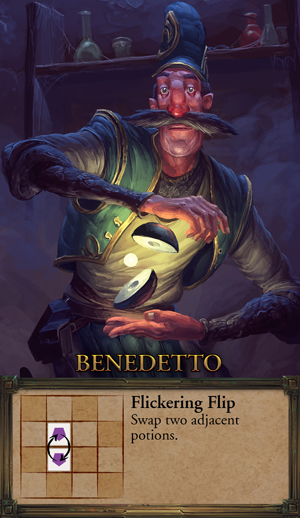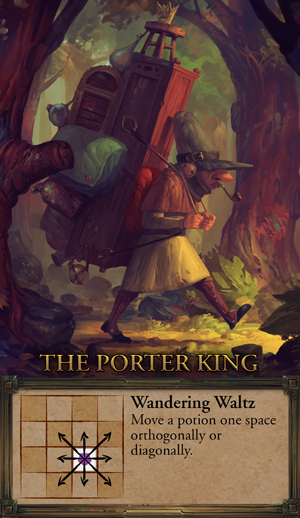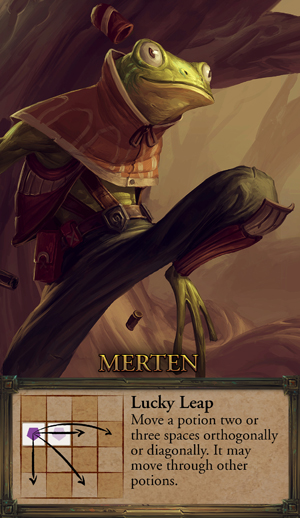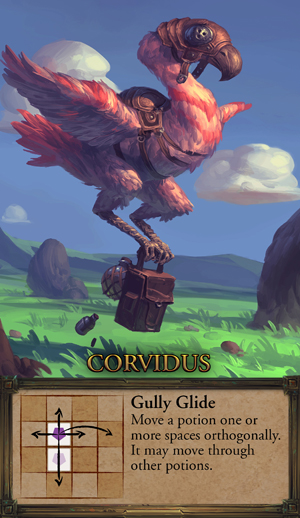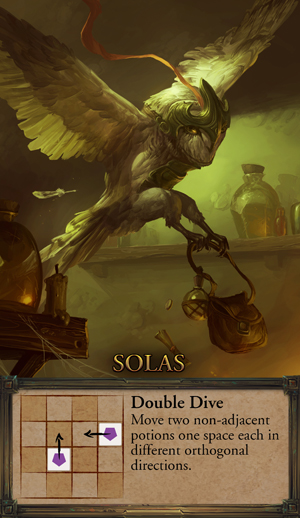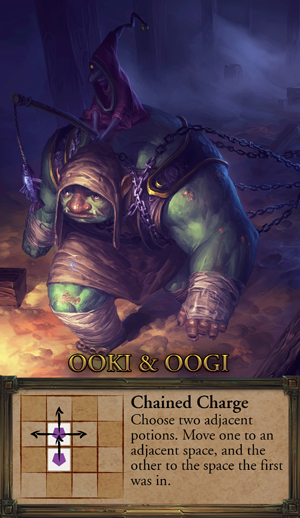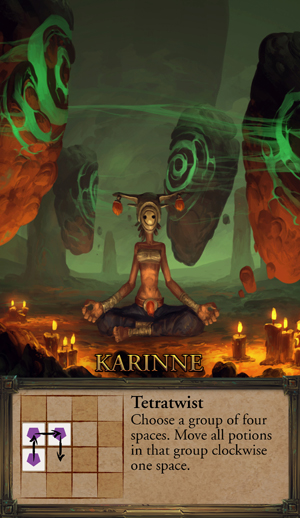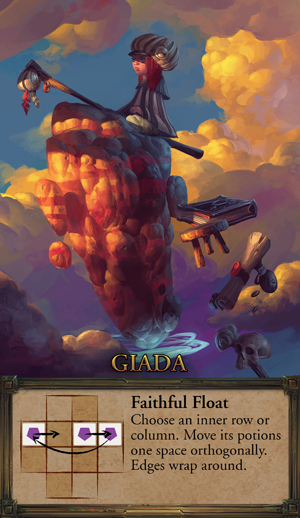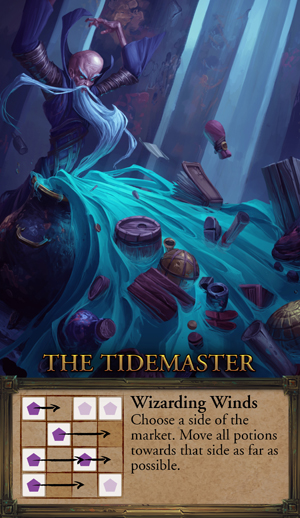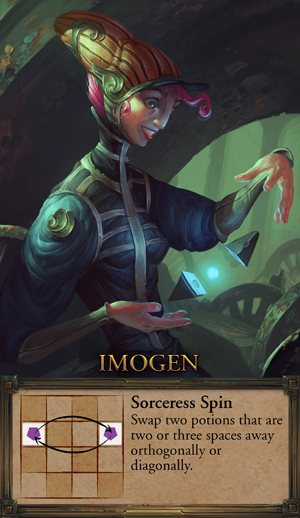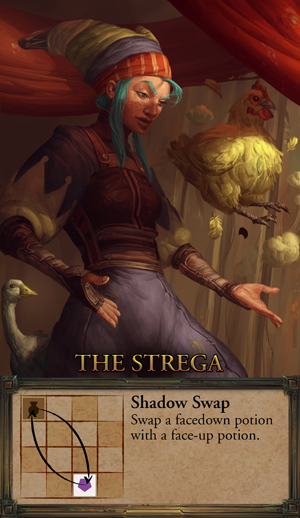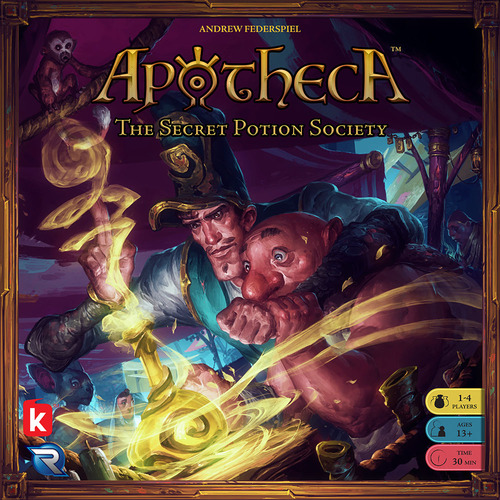Mechanically speaking, Apotheca is not a complicated game. It’s largely intuitive with only a handful of concrete rules, ensuring that it can be taught in just a couple of minutes. Yet the game’s simple concept belies a rich and often cerebral mind game with your opponents, courtesy of its seamless blend of spatial components, hidden information, and tile matching.
This wasn’t always the case, however. Apotheca was initially conceived primarily using its match-3 mechanic. To ensure that it offered a more diverse experience without venturing into abstract game territory, brainstorming was done to come up with another system to pair it with. After some trial and error, the solution revealed itself in the form of asymmetrical player powers – what we now know in-game as the Apothecaries. In an effort to share how that process evolved, Apotheca designer Andrew Federspiel has graciously offered up a design journal on that very topic. We’ll let him take it from here.
Enjoy!
Not familiar with Apotheca? Check out the game summary and game rules. Also, for the uninitiated: the word “orthogonal” means “horizontal or vertical, but not diagonal.”
In Apotheca, players brew potions on a 4×4 grid by matching three of the same color in a row. Inspired by match-3 mobile games, I set out to translate this to board game form. A couple prototypes in, a design question quickly arose: If the matched potions must be the same color, how do you set up matches for yourself without setting up your opponents?
The answer lies in asymmetry. Like many games, early Apotheca versions assumed that each player more or less starts with the same capabilities. At the time, players could play potions from their hand to seed the board, and then swap adjacent potions to make matches. This quickly led to problems as players felt “locked out” of the matches they wanted to make, because setting up a match often lead to their opponents making it instead. It became apparent that each player needed an “edge.”
Drawing The Power Curve
Upon reflection, I noticed that “swap two things” was an element of a larger picture – movement types in the world of abstract strategy games. Once I acknowledged this, I tested mechanics from other abstracts and went to town. The results were immediately intriguing. Asymmetrical abilities created an interesting dynamic where each had a different value depending on the state of the board. Think of the knight vs. the bishop in chess, for example – they are relatively equal in value, and each can be useful or useless depending on the current circumstances.
Establishing a power value spectrum was an important aspect to balancing Apotheca. In other words, how weak or powerful should powers be in relation to each other? The ideal is that all powers are balanced perfectly, but it is realistic that some larger range must be acceptable. Otherwise there’d be very little content in the game. It’s especially tough in a game that has no numeric values on powers for fine tuning. This brought up a number of questions:
- How do we design multiple abilities that are all unique yet balanced?
- Will the powers need to overlap in function to achieve this balance? How much are we willing to let them overlap?
- Is it ok if some powers are narrower or wider in terms of the potential in the spectrum? For example, how bad are they at their worst, and how good are they at their best, and are we ok with those values?
- Where do we even start with the value spectrum? What is our baseline?
The baseline began with the “swap two adjacent potions” power, now called Flickering Flip. Two other powers were quickly recognized as “balanced” and assimilated into the core spectrum: the Chess “king” move, called Wandering Waltz, and the Checkers “jump” move, called Lucky Leap (though initially orthogonal only). The main question became: what other fun, straightforward powers are there that are relatively close in power level to these abilities?
An Evolving Chess Board
In the spirit of keeping things simple, a natural progression was to the “knight” move, Portal Pounce, and the “rook” move, Gully Glide. While Portal Pounce proved balanced, the classic rook move was not powerful enough in Apotheca because the grid size is so small and congested. It’s tough to capitalize on infinite range if the board is only 4×4, especially when other potions can block movement. To buff the power, we allowed it to move potions through other potions and paired it with the bird theme to help explain the “move through” (or “fly over”) mechanic.
On a related note, for a long time, Solas’s Owl Swoop was a “bishop” that could move through other potions. This is why he is also a flying animal. But even with the ability to move potions through other potions, he was not powerful enough. He exhibited the problem that bishops have in chess: the moved potions could never switch to the other diagonal spaces on the grid. The potion he moved would be stuck on half the squares of the board (think white vs. black squares in Chess). This was problematic in a game with orthogonal-only matches.
We amped up Solas and renamed his power to Double Dive. This simultaneously moved two potions diagonally instead of one. After testing, it still wasn’t powerful enough. We later changed it to be orthogonal movement of two potions, but then the ability overlapped with Ooki & Oogi’s Chained Charge. To differentiate them, we tested orthogonal Double Dive with a requirement that the potions had to be non-adjacent. This caused Solas to swing from being the worst apothecary to being one of the best. Unfortunately, he then overlapped too much with the several other “slide” powers since he could slide two adjacent potions over by a row or column. There simply became too many applications for the ability, introducing Analysis Paralysis.
So, we added another restriction that the potions have to move in two different directions, which balanced him out. At first we thought this might be too complicated, and admittedly it can be on first read for new players, but it’s easy to grasp once you do it one time. Also, it’s a unique, weirdly enjoyable power. It’s the only power that can take three diagonal potions of the same color and make a match out of them, and it’s a great power for making both an offensive and defensive move in the same action.
Coming Full Circle
While almost all the aforementioned powers are translated Chess moves, the other inspiration we drew from was the match-3 mobile games themselves. The “rotate,” or Tetratwist, the “row slide,” or Faithful Float, and the “collapse,” or Wizarding Winds, came from this design arena. The latter two were not perceived as balanced initially, and had different ways in which they could be developed.
Faithful Float felt strong for a long time. It wasn’t horribly overpowered, but we knew it was at the ceiling of our power spectrum. During development, Faithful Float could grab any row or column, including the edges of the board. We tried many different iterations of the ability to reduce its power. We needed a version that was still simple to understand and didn’t nerf its value too heavily, but still seemed overpowered. Players love things that feel overpowered!
We tried many different versions, including but not limited to: sliding just columns (not rows), swapping whole rows/columns instead of its slide power, and moving any row or column but only with 3 potions or less (nicknamed “Threeful Float”). In the end, we removed the edges of the board from Faithful Float’s
tendrils since they were found to be a culprit of its power, and doing this didn’t complicate it much. The power is still strong in certain circumstances and has many ways to respond to threats, but it also has its limits.
Wizarding Winds was also initially perceived to be too powerful. However, this was when players always had access to two powers – their specific power, and a power that was always shared between them. Players now have one apothecary much of the time, so its power got reduced. In addition, we found that Wizarding Winds’ lower limit value is small compared to other powers’, which balances out the high power scenarios (since it can get clogged up). Wizarding Winds also brought up AP concerns, but players love it regardless. In the end, Wizarding Winds sat within our power spectrum and was exciting for players, so we kept it in.
Tweaking the swap-fest was next. We had Flickering Flip, the quintessential orthogonal swap, but we hadn’t yet considered a diagonal swap Imogen was born for this, but she ultimately proved not powerful enough since potion matches in Apotheca are orthogonal, not diagonal. We changed her to be an orthogonal “big swap”. She can swap potions 2 or 3 spaces away from each other. This was fun but still a bit weak, so we added the ability for her “big swap” to also work diagonally in a pinch. It was just the touch she needed.
The Last Puzzle Piece
Finally was The Strega’s Shadow Swap. It began as “center-to-edge” swap – swap anything in the center of the board with anything on the edge of the board (face-up or face-down didn’t matter). This was very powerful, but like the original Faithful Float, it was near the value spectrum ceiling. As part of our reigning-in process to narrow the power spectrum, testing showed she needed to be adjusted. The most elegant and fun solution was her current design, which coincidentally went really well with her power name. No other power cares whether the potions they interact with are face-up or face-down, so it’s cool that that’s her unique bent on things. It’s a limitless swap, with that one important caveat.
That’s a sampling of the tweaks and tuning needed to balance Apotheca. There are many, many other development tales I could mention, but I think that’s enough design talk for now! We ended up with a value spectrum that I am happy with, where none of the powers are really overpowered nor underpowered. Some are more consistent than others, while others have more power potential, but this was deliberate. That mix of applications and potential is what gives the game great variety, which gets compounded when the hidden information and deduction elements are added in.
Welp, time to get back to brewing games… cheers!
Apotheca will be released to retail on April 27th. What will your favorite power be?
Andrew Federspiel is the designer of Apotheca and founder of Knapsack Games. For the most up to date info, you can check out the website. Andrew can also be readily found on Twitter.
You can discuss this, and other articles, on our social media!
Photo Credits: Apotheca images by Knapsack Games.

